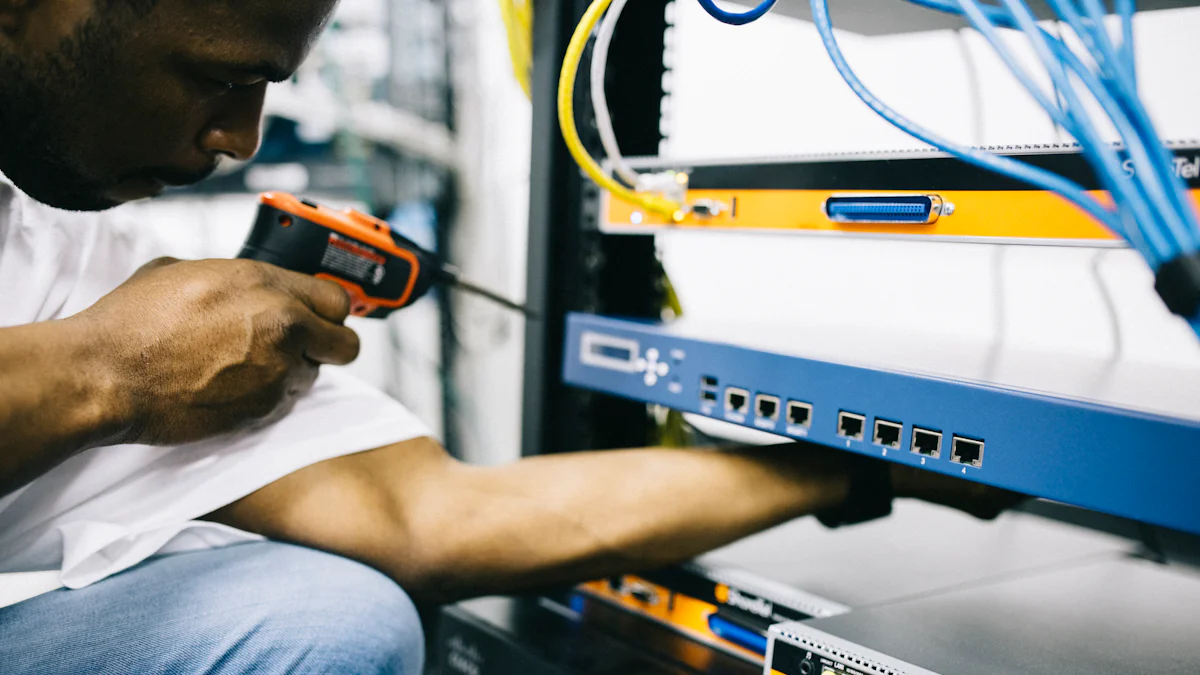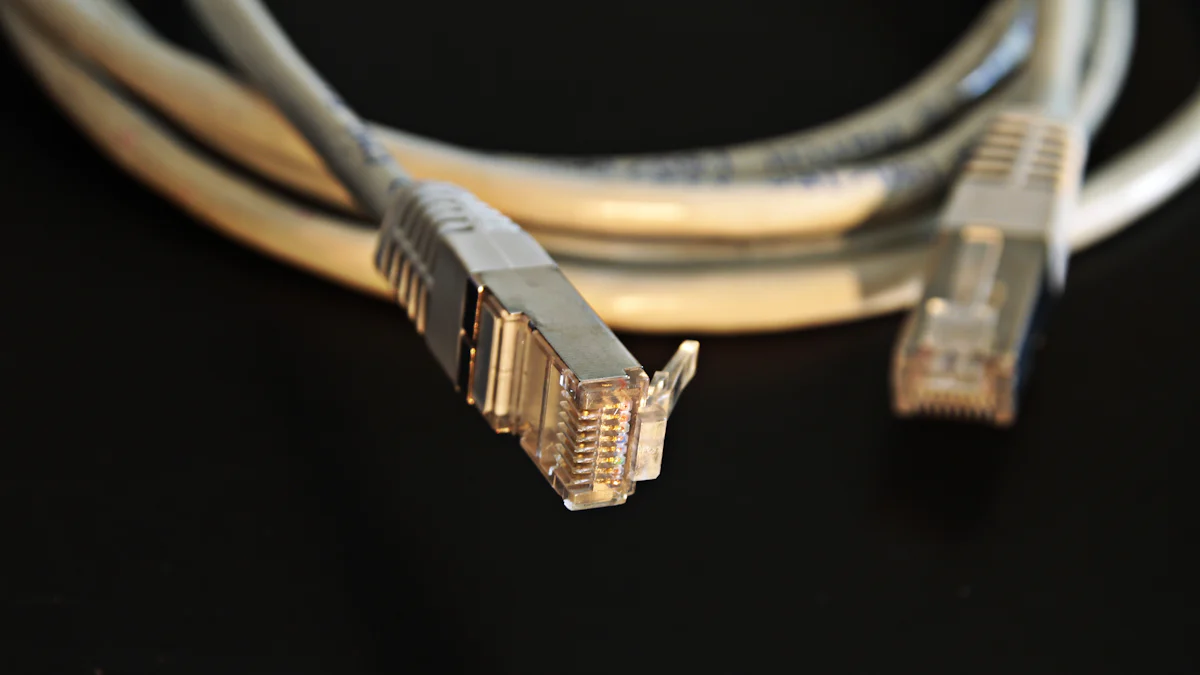What Are the Different Types of RF Connectors?

RF connectors play a crucial role in the world of electronics, serving as the vital link between devices to ensure seamless signal transmission. These rf connectors are indispensable in various applications, from radios to antennas. The demand for high-frequency rf connectors has surged with advancements in wireless technologies like 5G. This growth is evident as the global rf connector market is projected to reach $3.06 billion by 2030. Among the popular rf connector types, BNC connectors lead the market due to their reliability and versatility. Understanding these rf connectors' significance helps in appreciating their impact on modern communication systems.
Understanding RF Connectors
Definition and Function
What are RF Connectors?
RF connectors serve as essential components in electronic systems, facilitating the connection of radio frequency signals between devices. These connectors ensure that signals transmit efficiently without significant loss or interference. They come in various forms, each designed to meet specific requirements in terms of frequency range, impedance, and mechanical durability. The design of an RF connector often includes a central conductor, an insulating layer, and an outer conductor, which work together to maintain signal integrity.
How do RF Connectors Work?
RF connectors operate by providing a secure and stable connection between cables and devices. The central conductor carries the signal, while the outer conductor acts as a shield against electromagnetic interference. This configuration helps maintain the quality of the transmitted signal. Proper alignment and connection are crucial, as any misalignment can lead to signal degradation. Regular maintenance and careful handling of RF connectors are vital to ensure their longevity and performance.
Importance in Electronics
Role in Signal Transmission
RF connectors play a pivotal role in signal transmission, especially in high-frequency applications. They ensure that signals pass from one component to another with minimal loss. In wireless communication systems, such as 5G networks, RF connectors are indispensable. They connect antennas to transmitters and receivers, enabling seamless communication. The demand for high-frequency RF connectors has surged due to advancements in wireless technologies, highlighting their importance in modern communication systems.
Impact on Device Performance
The performance of electronic devices heavily relies on the quality of RF connectors. Poorly designed or degraded connectors can lead to signal loss, affecting the overall functionality of the device. For instance, in telecommunications, a faulty RF connector can disrupt communication, leading to data loss or poor connectivity. Therefore, selecting the right RF connector is crucial for ensuring optimal device performance. Environmental factors, such as temperature and humidity, can also impact the performance of RF connectors, making it essential to choose materials that withstand these conditions.
Types of RF Connectors

RF connectors come in various types, each designed to meet specific needs in electronic systems. Understanding these different rf connector types helps in selecting the right one for a particular application.
Coaxial Connectors
Coaxial connectors are widely used in RF applications due to their ability to maintain signal integrity over long distances. They consist of a central conductor, an insulating layer, and an outer conductor that acts as a shield.
BNC Connectors
BNC connectors are popular in RF applications requiring quick connect and disconnect capabilities. They feature a bayonet-style locking mechanism, ensuring a secure connection. BNC connectors are available in 50-ohm and 75-ohm versions, making them versatile for various applications, including video and radio frequency transmission.
TNC Connectors
TNC connectors are similar to BNC connectors but with a threaded design. This threading provides a more secure connection, reducing issues related to vibration. TNC connectors operate at higher frequencies than BNC connectors, making them suitable for applications requiring enhanced performance and stability.
Threaded Connectors
Threaded connectors offer a robust connection, ideal for environments where vibration or movement might compromise signal integrity.
SMA Connectors
SMA (SubMiniature version A) connectors are small, threaded coaxial connectors used in high-frequency applications. They have a 50-ohm impedance and can handle frequencies up to 18 GHz. SMA connectors are known for their durability and are commonly used in wireless communication systems, including cellular networks and GPS devices.
N-Type Connectors
N-type connectors are medium-sized RF connectors designed for applications requiring durability and stable performance. They feature a thread-locking mechanism, providing a strong and reliable connection. N-type connectors can operate up to 11 GHz, making them suitable for various telecommunications and broadcast applications.
Push-On Connectors
Push-on connectors offer ease of use with their snap-on mating design, making them ideal for applications where quick connections are necessary.
SMB Connectors
SMB connectors are compact RF connectors designed for high-frequency performance in a small package. They have a 50-ohm impedance and can handle frequencies up to 6 GHz. SMB connectors are commonly used in cellular base stations, Wi-Fi networks, and satellite communications due to their ease of use and reliable performance.
MCX Connectors
MCX connectors are smaller than SMB connectors and provide similar performance characteristics. They are used in applications where space is limited, such as in GPS systems and portable communication devices. MCX connectors offer a quick and easy connection, making them a popular choice in consumer electronics.
Features and Characteristics
Electrical Properties
Impedance
Impedance plays a crucial role in the performance of connectors. It refers to the resistance that an electrical circuit presents to the flow of alternating current. Most connectors, like SMA and BNC, are designed with specific impedance values, typically 50 or 75 ohms. This specification ensures compatibility with the devices they connect. Proper impedance matching minimizes signal reflection and loss, which is vital for maintaining signal integrity. For instance, SMA connectors are known for their impedance matching capabilities, making them suitable for high-frequency applications.
Frequency Range
The frequency range of a connector determines its suitability for various applications. Different connectors operate efficiently within specific frequency bands. SMA connectors can handle frequencies up to 18 GHz, making them ideal for high-frequency applications. In contrast, SMB connectors perform better below 4 GHz, offering a cost-effective solution for lower frequency needs. Selecting the right connector based on frequency requirements ensures optimal performance and prevents signal degradation.
Mechanical Properties
Durability
Durability is a key consideration when selecting connectors, especially for applications exposed to harsh environments. Connectors like N-Type are designed for robustness, featuring a thread-locking mechanism that provides a strong and reliable connection. However, some connectors, such as SMA, may lack precision and durability, requiring careful examination before each use. Ensuring the durability of connectors helps maintain consistent performance and reduces the need for frequent replacements.
Size and Weight
Size and weight are important factors in applications where space is limited. Smaller connectors, such as MCX, offer similar performance characteristics to larger counterparts but in a more compact form. These connectors are ideal for portable devices and systems where minimizing weight is crucial. The choice of connector size and weight should align with the specific requirements of the application, ensuring efficient use of space without compromising performance.
Applications of RF Connectors

Telecommunications
RF connectors play a pivotal role in telecommunications, ensuring reliable signal transmission across various platforms.
Mobile Networks
In mobile networks, RF connectors facilitate seamless communication between devices and network infrastructure. They connect antennas to base stations, enabling efficient data transfer. High-frequency RF connectors are essential for 5G networks, where they support rapid data transmission and low latency. Moisture Vibration Proof RF Connectors have improved connection performance in tactical communication systems, highlighting their importance in maintaining robust mobile networks.
Satellite Communications
Satellite communications rely heavily on RF connectors to maintain stable connections between ground stations and satellites. These connectors ensure that signals transmit without significant loss, even over vast distances. The High Power RF Cables and Connectors case study demonstrated improved solutions for high-power coaxial transmission lines, crucial for military surveillance aircraft radar systems. This advancement underscores the importance of RF connectors in satellite communications, where reliability and performance are paramount.
Consumer Electronics
RF connectors are integral to consumer electronics, enhancing the functionality and performance of various devices.
Television and Radio
Television and radio systems use RF connectors to connect antennas and receivers, ensuring clear signal reception. These connectors help minimize interference, providing users with high-quality audio and video output. The versatility of RF connectors allows them to adapt to different impedance requirements, making them suitable for both analog and digital broadcasts.
Wireless Devices
Wireless devices, such as smartphones and tablets, depend on RF connectors for efficient signal transmission. These connectors link internal components, like antennas and transceivers, ensuring optimal device performance. In the High RF Power High Frequency Solutions for EMC Testing case study, new cable and interconnect options were provided, enhancing the performance of wireless devices in electromagnetic compatibility (EMC) testing environments. This innovation highlights the critical role of RF connectors in maintaining the functionality of modern wireless devices.
Considerations for Selection
Performance Requirements
Signal Integrity
Signal integrity stands as a critical factor when selecting connectors. It ensures that signals transmit with minimal loss or distortion. High-frequency connectors, such as SMA and N-Type, excel in maintaining signal integrity across various applications. They support existing and future technologies by adapting to ecological and economic conditions. This adaptability satisfies demands for performance and reliability. Users must consider the frequency range and impedance matching to ensure optimal signal transmission.
Environmental Conditions
Environmental conditions significantly impact connector performance. Factors like temperature, humidity, and vibration can affect the durability and functionality of connectors. For instance, connectors used in outdoor or industrial settings must withstand harsh conditions. N-Type connectors, known for their robustness, provide reliable performance in challenging environments. Selecting connectors with appropriate materials and sealing mechanisms ensures longevity and consistent performance.
Cost and Availability
Budget Constraints
Budget constraints often influence the choice of connectors. While high-performance connectors offer superior features, they may come at a higher cost. Users must balance performance requirements with budget limitations. Cost-effective options, like SMB connectors, provide reliable performance for lower frequency applications. Evaluating the specific needs of the application helps in making informed decisions without compromising quality.
Supplier Options
Supplier options play a crucial role in the availability and quality of connectors. Reliable suppliers offer a wide range of connectors, ensuring compatibility with various applications. They provide technical support and customization options to meet specific requirements. Users should consider factors like supplier reputation, product quality, and delivery timelines when selecting connectors. Establishing a relationship with trusted suppliers ensures access to high-quality connectors and support for future needs.
RF connectors hold immense importance in electronic systems, ensuring efficient signal transmission across various applications. Their diversity caters to specific needs, from robust military systems to consumer electronics. Selecting the right connector involves understanding performance requirements and environmental conditions. As a Winchester’s customer noted, "This connection was critical to the overall performance of the system." Similarly, an aerospace customer highlighted the challenges of existing solutions, emphasizing the need for flexibility and ease of use. By considering these factors, users can make informed decisions, enhancing the reliability and functionality of their devices.
See Also
In-Depth Analysis on Various Cable and Connector Options
Exploring Various Kinds of Crimping Devices
Professional Recommendations: Top Crimping Tools for Specific Uses
